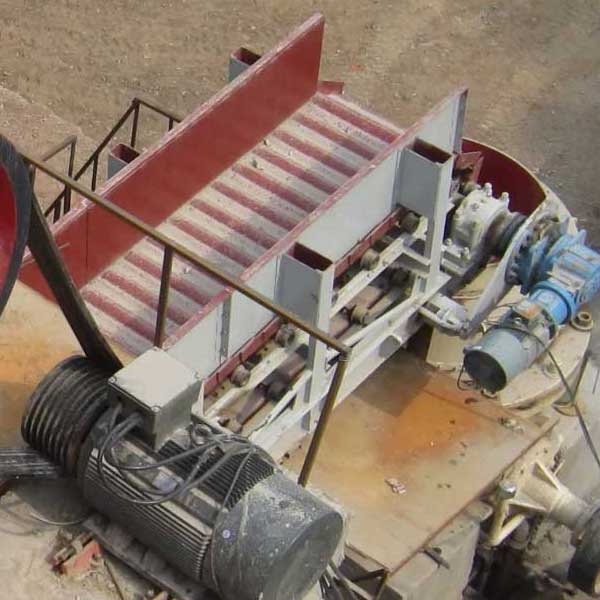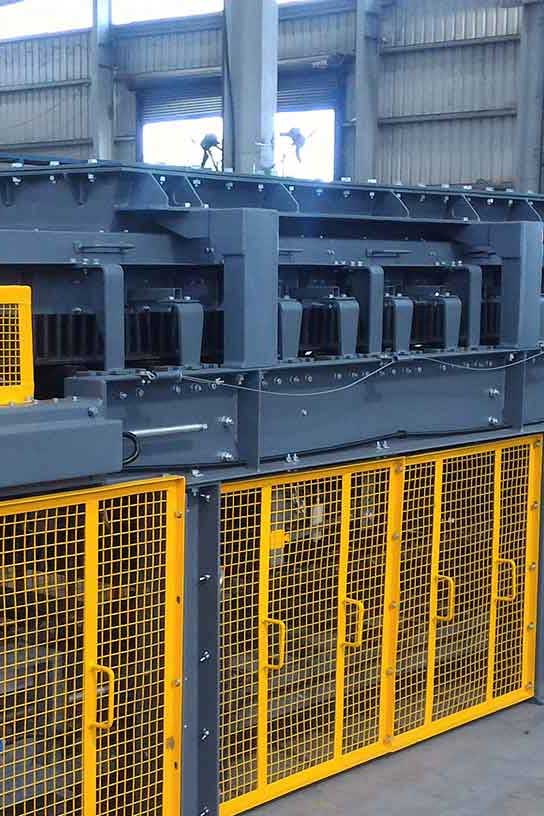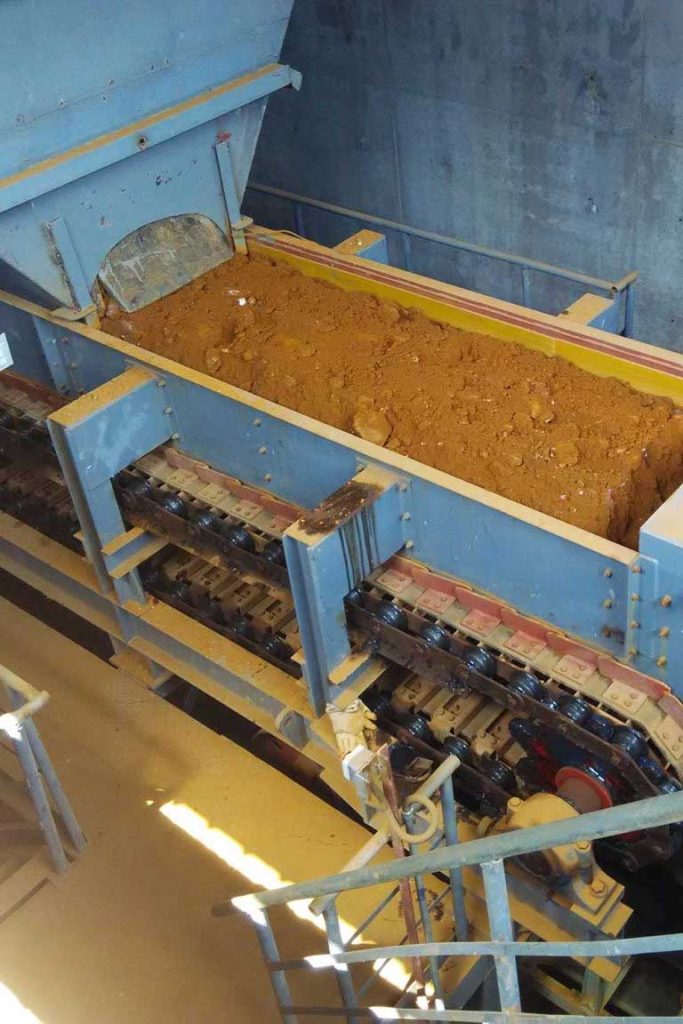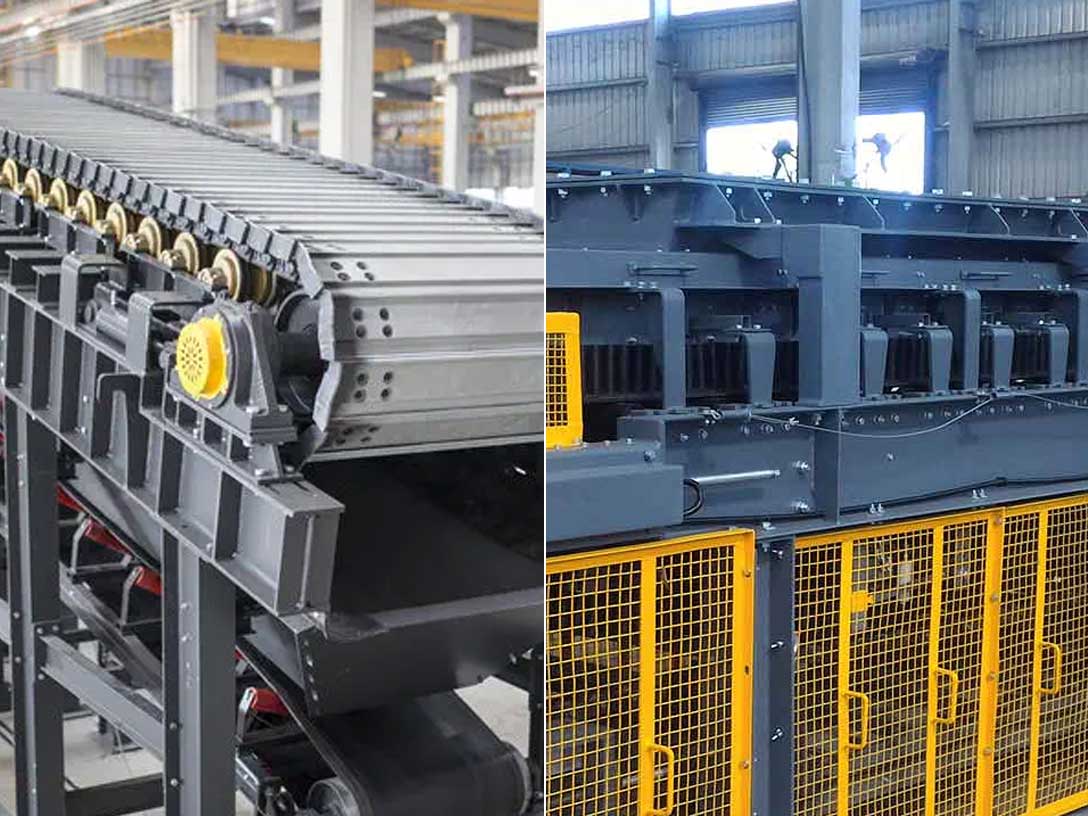Feeders are typically found at the base of the hopper in many crushers and screens, their job is to transport the material at a controlled rate of speed from the hopper onto the screen, crusher, or feed conveyor.
Belt feeders are the backbone of high-capacity bulk material feeding in mining and heavy industry. They can be designed to handle a great variety of bulk materials ranging from abrasive, large, lumpy iron ore to delicate, wet, sticky filter cakes.
An apron feeder is a reliable feeding method for when the material to be conveyed is lumpy, abrasive, heavy, high temperature, or where a feeding solution more robust than a traditional belt feeder is required.
Apron feeders and belt feeders are used extensively for heavy-duty mineral processing operations and are often confused as alternatives, the question is often which one is better? Answer: the apron feeders and belt feeders vary significantly in design and have different applications.

Apron feeder
The apron feeder is built from undercarriage chains, rollers, and tailwheels, similar to the tracks you would find on a bulldozer. Two undercarriage systems are placed side by side and joined together by heavy-duty grouser bars. The links are sealed to prevent aggregate from penetrating and wearing out the system.
An apron belt feeder eliminates the high pull-out tension carried by the belt by transferring this tension directly into two strands of the dozer chain via connecting cross beams (similar to apron feeder pans)
Four Pros
- Built from hardened steel
- Not prone to slips
- Can take heavy loads (rocks up to 600mm)
- Can take impacts
- Can handle many different types of materials
- Better for bark and mulch applications
- Wear takes a lot longer
Four Cons
- More upfront investment
- Slow-moving
- Can be worn out by very wet fine material
- Can have some leakage of fines
.
Application
Apron feeders can extract materials from bins, hoppers, and stockpiles. They can transfer materials across a short distance at a highly controlled rate of speed and weather several impacts of free-falling bulk material.
Apron feeders are well suited for handling wet and lumpy material. They are widely used in metal ore processing which the much more heavy-duty and can handle rocks up to 600mm+.
Read More: Apron Feeders, Everything You Need to Know, Best Guide 2023

Belt feeder
Belt feeders use a single endless hardened rubber belt, a driving drum, an idle drum, and more rollers. The nature of this system allows the transportation of material typically smaller than 300mm over longer distances at higher speeds. Belt feeders use standard, cost-effective components, and the method of operation and design principles are well understood.
Four Pros
- Suitable for small materials wet or dry
- Better suited to smaller materials (max size 300 mm)
- Moves faster
- Less upfront investment
Four Cons
- It can require more maintenance
- Cannot tear with sharp material
- Cannot drop material on to belt as it may cause damage
- Possibility for material to slip on the belt
Application
Belt feeders are designed to carry material across longer distances and can extract material from bins and hoppers via a loading chute. Belt feeders allow volumetric control of materials, but they cannot be used in operations requiring a shallow rate of material flow.
Belt feeders are widely implemented in coal mining operations, where the material is smaller lumps less than 20″ in size.
Read More: Conveyor belt Wikipedia

Difference Between the Apron Feeders and Belt Feeders
Apron feeders are best suited to primary applications. Wherever there is likely to be big heavy material with sharp edges that may be dropped from a height, apron feeders will always be the better choice in this situation. This also applies to uses such as bark, mulch, or recycling that are prone to slip on top of a belt.
Belt feeders are much better for secondary applications, they are typically used for material no larger than 6” and are not suited for impact, larger material, and heavy loads as well as Apron Feeders.
Belt Feeders can carry material longer distances than Apron Feeders. They also operate at faster speeds than Apron Feeders because high rates can cause accelerated wear on Apron Feeders, however, come with the added cost of servicing regularly and are much more prone to damage.
Apron Feeders vs Belt Feeders
Apron feeder and belt feeder are two common types of feeders used in various industrial applications, such as mining, quarrying, and construction. Both feeders are designed to feed bulk material from one process to another, but there are some differences between the two that make them more suitable for different scenarios.
Apron Feeder
An apron feeder, also known as a plate feeder, is a heavy-duty feeder that consists of a series of overlapping steel plates or pans that are mounted on chains with rollers. The plates or pans are typically made of steel and can range in thickness from 10 to 50mm, depending on the application.
The apron feeder is designed to handle heavy and abrasive materials, such as large rocks and ore, as well as sticky materials that tend to cling to the pan surface. It can deliver material at a rate of up to 5,000 tons per hour and can handle lumps up to 2,000 mm in size.
The main advantage of the apron feeder is its ability to handle heavy materials without the risk of material spillage or blockage. The overlapping design of the pans ensures that the material is contained within the feeder, preventing it from spilling out. In addition, the heavy-duty construction of the feeder makes it more durable and resistant to wear and tear, which is essential in harsh and abrasive environments.
On the other hand, the main disadvantage of the apron feeder is its higher initial cost compared to the belt feeder. Due to its heavy-duty construction and assembly, the apron feeder requires more time and resources to install, maintain, and repair.
Belt Feeder
A belt feeder, also known as a conveyor belt feeder, is a conveyor that involves a rubber belt that is driven by a series of pulleys. The belt is typically flat and can be made of various materials, such as rubber, PVC, or nylon. The belt can carry materials ranging in size from fine powders to heavy and bulky items.
The belt feeder is designed to handle a wide range of materials, such as sand, gravel, coal, and grain. It can deliver material at a rate of up to 1,000 tons per hour and can handle lumps up to 150 mm in size.
The main advantage of the belt feeder is its lower initial cost compared to the apron feeder. The design of the belt feeder is less complex and requires less time and resources to install, maintain, and repair. In addition, the rubber belt is more flexible and can adapt to changes in the material flow, reducing the risk of material spillage or blockage.
On the other hand, the main disadvantage of the belt feeder is its limitation in handling heavy and abrasive materials. The rubber belt is not as durable and resistant to wear and tear as the steel pans of the apron feeder. This makes the belt feeder less suitable for harsh and abrasive environments.
Final words
At the end of the day, the decision between the two lies in the specific application and what the needs of your quarry are.
